You have hired a landscape architect and had an initial site meeting, during which you walked the property and discussed priorities, a budget and a project timeline. Now the landscape architect is coming over to present your property’s concept design. Many clients don’t know what to expect in this early stage of design.
The concept design sets the vision and tone for the project and is the first design phase of working with a landscape architect. The landscape architect has been busy sketching in the studio, studying site photos and reviewing notes from your first meeting to create the first overall concept plan. The concept plan is usually supported by different types of drawings to convey the design intent and what the space will feel and look like once it is built.
Here's how the process of concept design works and how your feedback can improve the project.
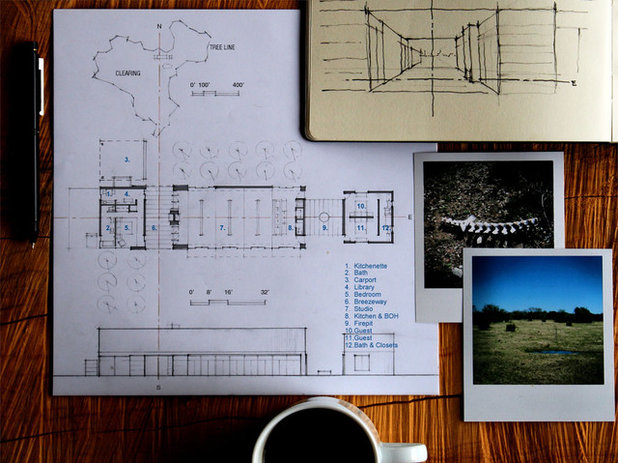
NIMMO American Studio For Progressive Architecture
The PresentationThe elements in this photo are what a designer might use to present an overall idea to a client. Inspiration photos and a variety of drawings show how the building is sited, what the views are like and how the space is organized.
The landscape architect will use images and drawings to walk you through the design ideas and layout. He or she will begin with a concept or an inspiration and an explanation of the major ideas and layout, supported by more detailed drawings. The landscape architect often will present one overall scheme for the design as a concept-level plan and then show additional options, such as material choices, types of plants and layout schemes for major site elements for specific areas.
Find landscape architects in your area
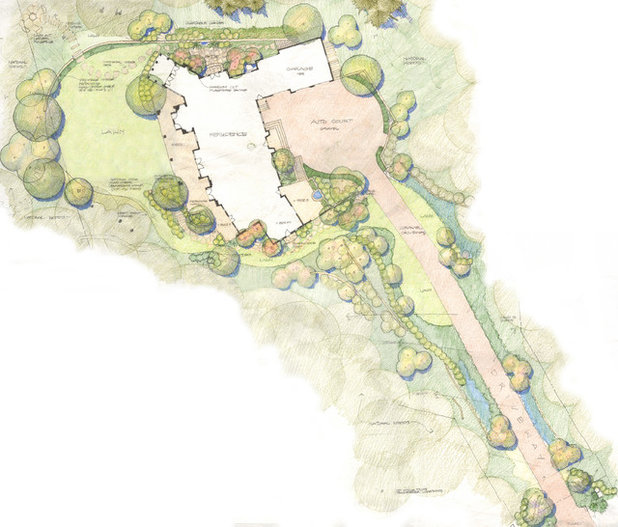
Jacobs Grant Design ltd
Drawings to Support the Concept DesignConcept plan. The site plan, drawn at a concept level, as this one is, shows the overall layout. The concept site plan is loose, showing major layout ideas and identifying areas of the garden for use.
When evaluating your landscape architect’s concept plan, think about the big picture and the overall features of the design. The details will come later in the design process.
The level of detail in the plan will depend on the size of the property. The concept plan might not identify specific species of plants but instead list the type of plant and a series of suggestions. A specimen tree, for example, could be any tree serving as a focal point, such as a deciduous large canopy tree with great autumn color. A list of trees fitting those qualifiers could include sugar maple, northern red oak or tulip tree, depending on your setting and preferences. A shaded garden hedge might include a mix of ericaceous evergreen shrubs, and so on.
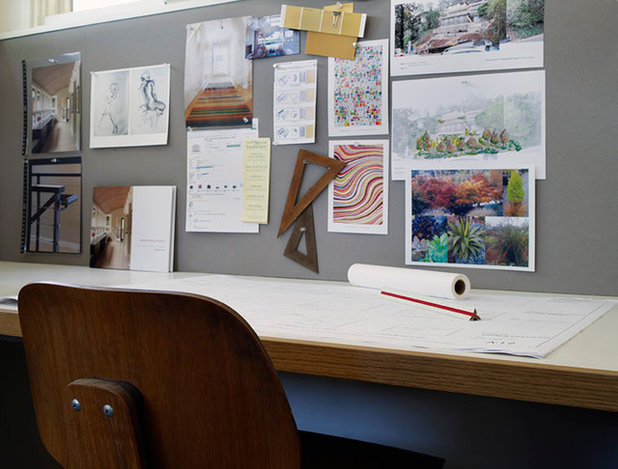
Sharon Portnoy Design
Mood boards. This image of a designer’s desk shows a collection of plants, patterns, colors and inspirational images hung above the drawing surface. Designers of all types use mood boards, also called inspiration boards, to bring their sources of inspiration together into one collage. Landscape architects use mood boards and ideabooks here on Houzz to capture details, materials, natural settings and more.
The point of the mood board is to distill the inspiration into one board that represents the design’s major visual elements. For a landscape plan, this might include patterns, colors and historic garden precedents that inform the design. The mood board may be presented to the client at the concept review meeting, or it may only be talked about.
How to Create and Use Ideabooks
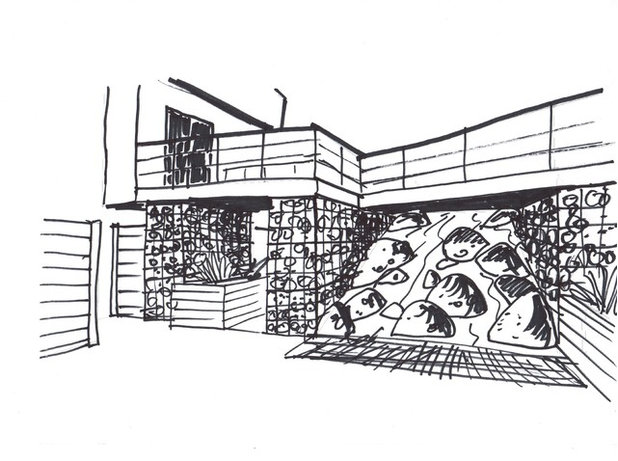
Bockholt Landscape Architecture
Sketches. A sketch is an essential first drawing of an idea. It could be for a layout, a view, a section or a design detail. The sketch is a speedy way to put an idea on paper and is used to quickly test out a few options by hand. Many of the sketches by the landscape architect will be left at the office and only the most pertinent ideas brought to the concept design review meeting.
Sketches are a quick way to explain an idea. Respond intuitively when giving feedback. What is your gut reaction to the sketch? Sketches are often vague and open ended, and may spark a great conversation that leads the design in a new direction. The sketch shown here is intriguing because it shows a view of a courtyard where it meets an upper porch. There is a lot of vagueness in what the material components might be, but the intent is clear.

Bockholt Landscape Architecture
Perspective renderings. The landscape architect may create digital perspective renderings in addition to hand drawings. These renderings, like the one shown here, are often created over existing photos of the property or by using images produced by an architect for proposed construction. Renderings give a feeling of the textures and atmosphere of the landscape design in relation to the greater context. The perspective is made with some artistic license but is the drawing most easily read by clients. With a perspective drawing, you should get a sense of the views and setting and be able to imagine yourself in the design.
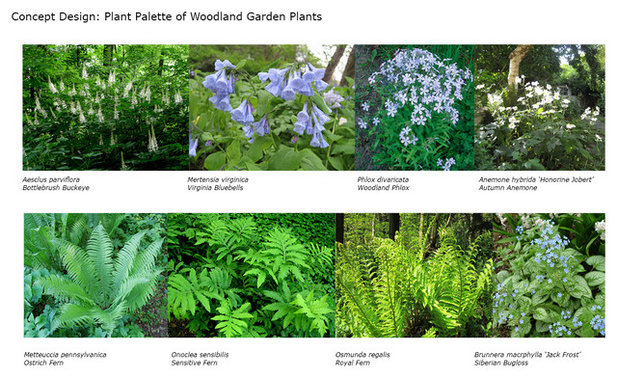
Falon Land Studio LLC
Plant palettes. The palette is a collection of specific plant species to be used as a starting point in the planting plan. This will create an overall look for the gardens in the concept stage of design. The plant palette here was made using blue- and white-blooming flowers to meet the client’s request for cool-colored blossoms. This palette represents one area — the woodland garden area — within a larger landscape design.
A plant palette is useful because it shows the types of blooms, foliage textures, colors and plant forms that will make up the gardens and planting areas. Plant palettes also typically show various options for plant species to include in the final design. Some may be taken out and others added. When reviewing the plant palette during the concept design phase, give direct feedback to the landscape architect about which plants you like and which you don’t so that the palette can be refined in the next design phase.
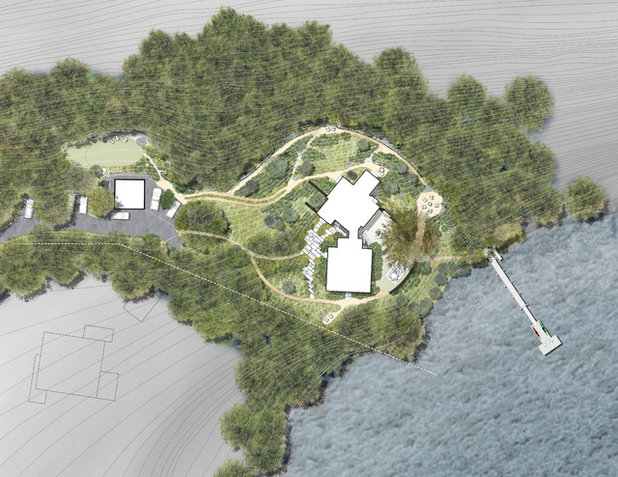
Matthew Cunningham Landscape Design LLC
Handling RevisionsRevisions are to be expected in the concept stage of design and are a normal part of the process. If you are not pleased with the concept design, simply tell the landscape architect that the concept is not what you want. The price for revisions is usually included in your service contract. If you are ever unsure about how time for revisions will be billed, simply ask.
Landscape architects are service professionals who strive to make clients happy with their work. Additionally, most residential landscape architecture firms are local small businesses that rely on producing quality work and providing great service to their clients.
Ideally, the discussion will move toward refinement of the concept plan with clear next steps and a timeline for completion.
Next: How to Find and Hire a Great Landscape Contractor





